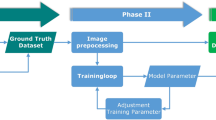Abstract
Automatic cardiac MRI segmentation, including left and right ventricular endocardium and epicardium, has an essential role in clinical diagnosis by providing crucial information about cardiac function. Determining heart chamber properties, such as volume or ejection fraction, directly relies on their accurate segmentation. In this work, we propose a new automatic method for the segmentation of myocardium, left, and right ventricles from MRI images. We introduce a new architecture that incorporates SERes blocks into 3D U-net architecture (3D SERes-U-Net). The SERes blocks incorporate squeeze-and-excitation operations into residual learning. The adaptive feature recalibration ability of squeeze-and-excitation operations boosts the network’s representational power while feature reuse utilizes effective learning of the features, which improves segmentation performance. We evaluate the proposed method on the testing dataset of the MICCAI Automated Cardiac Diagnosis Challenge (ACDC) dataset and obtain highly comparable results to the state-of-the-art methods.
Access this chapter
Tax calculation will be finalised at checkout
Purchases are for personal use only
Similar content being viewed by others
References
A.C.D.C.A.M.C.: Post-2017-miccai-challenge testing phase. https://acdc.creatis.insa-lyon.fr/#challenges (2017)
Arnold, J.R., McCann, G.P.: Cardiovascular magnetic resonance: applications and practical considerations for the general cardiologist. Heart 106(3), 174–181 (2020)
Baumgartner, C.F., Koch, L., Pollefeys, M., Konukoglu, E.: An exploration of 2d and 3d deep learning techniques for cardiac MR image segmentation. ArXiv arXiv:1709.04496 (2017)
Bernard, O., et al.: Deep learning techniques for automatic MRI cardiac multi-structures segmentation and diagnosis: is the problem solved? IEEE Trans. Med. Imaging 37(11), 2514–2525 (2018). https://doi.org/10.1109/TMI.2018.2837502
Cetin, I., et al.: A radiomics approach to computer-aided diagnosis with cardiac cine-MRI. In: Pop, M., et al. (eds.) STACOM 2017. LNCS, vol. 10663, pp. 82–90. Springer, Cham (2018). https://doi.org/10.1007/978-3-319-75541-0_9
Cheng, F., et al.: Learning directional feature maps for cardiac MRI segmentation. In: Martel, A.L., et al. (eds.) MICCAI 2020. LNCS, vol. 12264, pp. 108–117. Springer, Cham (2020). https://doi.org/10.1007/978-3-030-59719-1_11
Click, O., Abdulkadir, A., Lienkamp, S.S., Brox, T., Ronneberger, O.: 3d u-net: Learning dense volumetric segmentation from sparse annotation. CoRR abs/1606.06650 (2016). http://arxiv.org/abs/1606.06650
Duan, J., et al.: Automatic 3d bi-ventricular segmentation of cardiac images by a shape-refined multi- task deep learning approach. IEEE Trans. Med. Imaging 38(9), 2151–2164 (2019)
Habijan, M., Leventić, H., Galić, I., Babin, D.: Estimation of the left ventricle volume using semantic segmentation. In: 2019 International Symposium ELMAR, pp. 39–44 (2019). https://doi.org/10.1109/ELMAR.2019.8918851
Habijan, M., et al.: Overview of the whole heart and heart chamber segmentation methods. Cardiovasc. Eng. Technol. 11(6), 725–747 (2020)
He, K., Zhang, X., Ren, S., Sun, J.: Deep residual learning for image recognition. In: 2016 IEEE Conference on Computer Vision and Pattern Recognition (CVPR), pp. 770–778 (2016). https://doi.org/10.1109/CVPR.2016.90
Hu, J., Shen, L., Sun, G.: Squeeze-and-excitation networks. In: 2018 IEEE/CVF Conference on Computer Vision and Pattern Recognition, pp. 7132–7141 (2018). https://doi.org/10.1109/CVPR.2018.00745
Isensee, F., Jaeger, P., Full, P.M., Wolf, I., Engelhardt, S., Maier-Hein, K.H.: Automatic cardiac disease assessment on cine-MRI via time-series segmentation and domain specific features. CoRR abs/1707.00587 (2017). http://arxiv.org/abs/1707.00587
Jang, Y., Hong, Y., Ha, S., Kim, S., Chang, H.-J.: Automatic segmentation of LV and RV in cardiac MRI. In: Pop, M., et al. (eds.) STACOM 2017. LNCS, vol. 10663, pp. 161–169. Springer, Cham (2018). https://doi.org/10.1007/978-3-319-75541-0_17
Khened, M., Varghese, A., Krishnamurthi, G.: Densely connected fully convolutional network for short-axis cardiac cine MR image segmentation and heart diagnosis using random forest. In: STACOM@MICCAI (2017)
Liu, T., Tian, Y., Zhao, S., Huang, X., Wang, Q.: Residual convolutional neural network for cardiac image segmentation and heart disease diagnosis. IEEE Access 8, 82153–82161 (2020). https://doi.org/10.1109/ACCESS.2020.2991424
Liu, Y., et al.: Distance regularized two level sets for segmentation of left and right ventricles from cine-MRI. Magn. Reson. Imaging 34 (2015). https://doi.org/10.1016/j.mri.2015.12.027
Lu, J.-T., et al.: DeepAAA: clinically applicable and generalizable detection of abdominal aortic aneurysm using deep learning. In: Shen, D., et al. (eds.) MICCAI 2019. LNCS, vol. 11765, pp. 723–731. Springer, Cham (2019). https://doi.org/10.1007/978-3-030-32245-8_80
Organization, W.H.: Mortality database (2018). Accessed 19 Jan 2021
Patravali, J., Jain, S., Chilamkurthy, S.: 2d–3d fully convolutional neural networks for cardiac MR segmentation. ArXiv arXiv:1707.09813 (2017)
Peng, P., Lekadir, K., Gooya, A., Shao, L., Petersen, S.E., Frangi, A.F.: A review of heart chamber segmentation for structural and functional analysis using cardiac magnetic resonance imaging. Magn. Reson. Mater. Phys. Biol. Med. 29(2), 155–195 (2016). https://doi.org/10.1007/s10334-015-0521-4
Ronneberger, O., Fischer, P., Brox, T.: U-net: convolutional networks for biomedical image segmentation. CoRR abs/1505.04597 (2015). http://arxiv.org/abs/1505.04597
Vigneault, D.M., Xie, W., Ho, C.Y., Bluemke, D.A., Noble, J.A.: Omega-net (omega-net): fully automatic, multi-view cardiac MR detection, orientation, and segmentation with deep neural networks. Med. Image Anal. 48, 95–106 (2018). https://doi.org/10.1016/j.media.2018.05.008
Zotti, C., Luo, Z., Humbert, O., Lalande, A., Jodoin, P.M.: Gridnet with automatic shape prior registration for automatic MRI cardiac segmentation. In: STACOM@MICCAI (2017)
Acknowledgement
This work has been supported in part by Croatian Science Foundation under the Project UIP-2017-05-4968.
Author information
Authors and Affiliations
Corresponding author
Editor information
Editors and Affiliations
Rights and permissions
Copyright information
© 2022 Springer Nature Switzerland AG
About this paper
Cite this paper
Habijan, M., Galić, I., Leventić, H., Romić, K., Babin, D. (2022). Segmentation and Quantification of Bi-Ventricles and Myocardium Using 3D SERes-U-Net. In: Rozinaj, G., Vargic, R. (eds) Systems, Signals and Image Processing. IWSSIP 2021. Communications in Computer and Information Science, vol 1527. Springer, Cham. https://doi.org/10.1007/978-3-030-96878-6_1
Download citation
DOI: https://doi.org/10.1007/978-3-030-96878-6_1
Published:
Publisher Name: Springer, Cham
Print ISBN: 978-3-030-96877-9
Online ISBN: 978-3-030-96878-6
eBook Packages: Computer ScienceComputer Science (R0)




